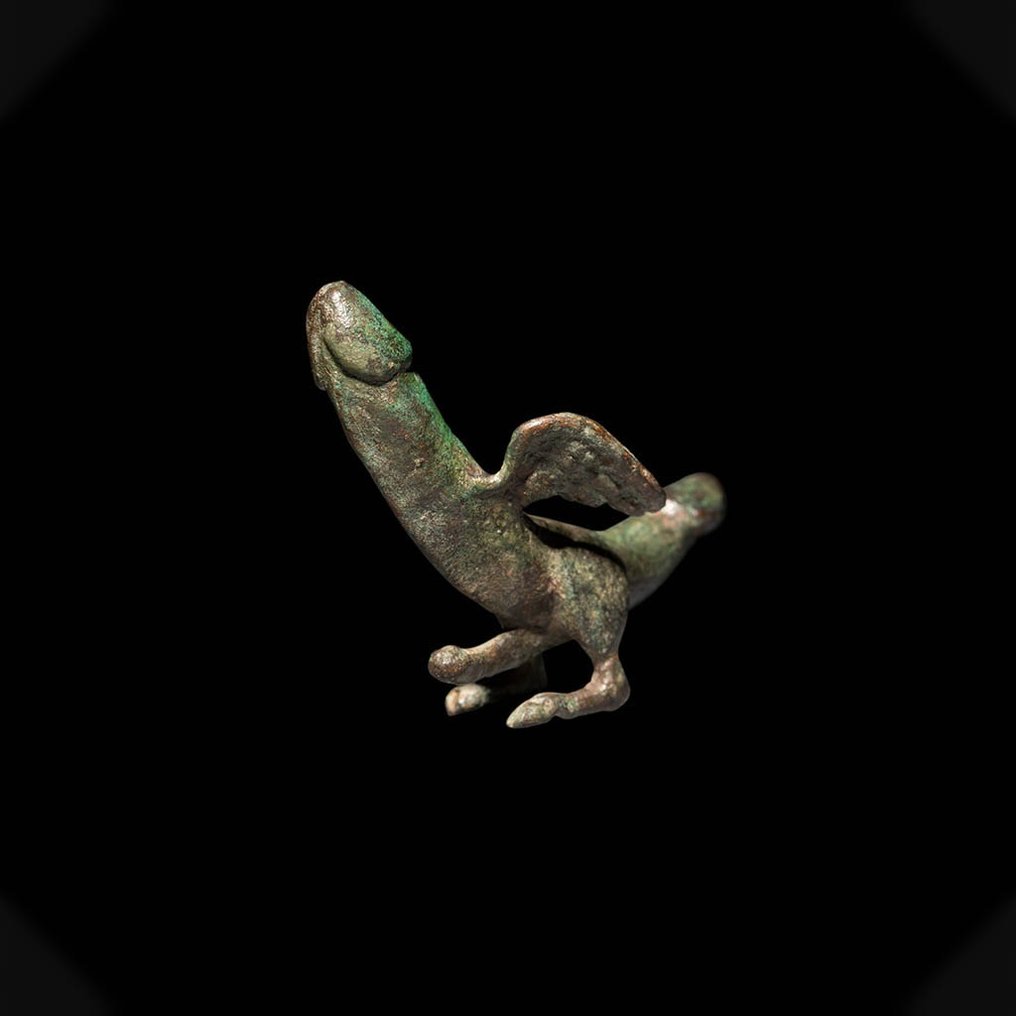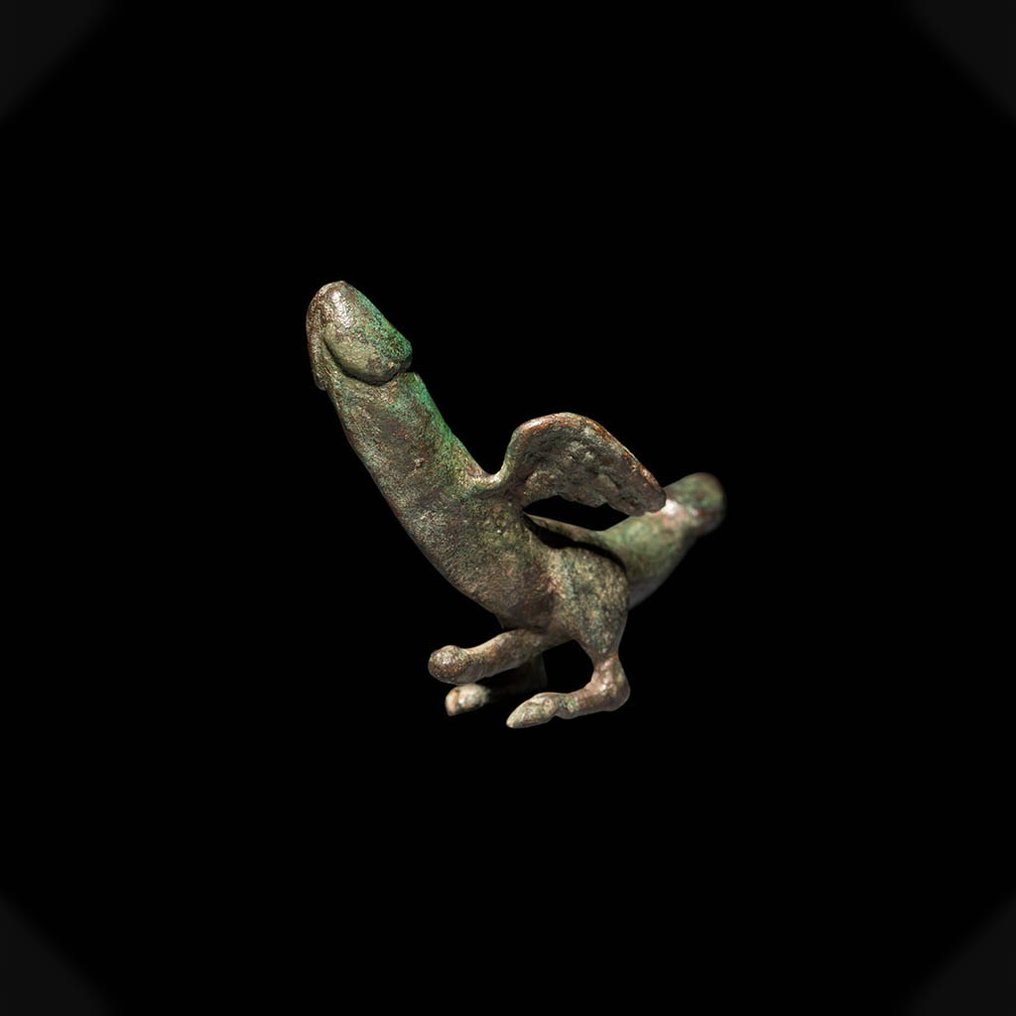Venditore eccellente. Articolo ben descritto e ben confezionato.
Se översättningRomerska antiken Brons Fallisk amulett med vingar. 1:a - 2:a århundradet e.Kr. 7,5 cm längd. Spansk exportlicens.
Nr 90344307



Phallic Amulet with Wings.
Ancient Roman, 1st - 2nd century AD.
MATERIAL: Bronze.
DIMENSIONS: 7.5 cm length.
PROVENANCE: Private collection, Great Britain. Acquired in the 1960s.
CONDITION: Good condition. Intact.
DESCRIPTION:
A triple phallic amulet representing a winged and erect male member, with two zoomorphic feet. At the same time, another smaller phallus can be seen between the lower limbs, and one more on a larger scale toward at the back of the first.
Sometimes named the “phallic bird” or “zoomorphic” phallus, the winged male sexual attribute was an habitual motif in Roman iconography, as it incorporated velocity, power, and rapidity. Numerous amulets of this type have been found throughout the Imperial realm, and helping to fill public and private collections.
This is a motif inherited from the Greek repertoire, as it symbolises the god Priapus, a minor divinity seen always with a permanent erection, an artistic resort with which to allude to the fecundity of nature, to abundance and harvests. At the same time, Priapus also had a role warding off the evil eye and protecting homes from thieves. This is the reason why the erect phallus appears on numerous amulets, oil lamps, statuettes and tintinnabula. The latter, generally made of bronze, were made up of a winged phallus from which wind chimes hung, and they were placed in gardens and porticos with the aim of protecting the property and bringing good fortune to the inmates. Various examples have been recovered from Pompeii, which testifies to the popularity of this fetish among the distinct social classes.
BIBLIOGRAPHY:
- Los bronces romanos en España. 1990. p. 251, figs. 167-169.
- GRANT. Eros in Pompeii, The Erotic Collection of the Museum of Naples. 1997. p. 139.
- JOHNS. Sex or Symbol? Erotic Images of Greece and Rome. 1990. n. 52.
PARALLELS:
Fig. 1. Tintinnabulum, bronze, from Pompeii, Museo Archeologico Nazionale di Napoli, inv. 27835.
Fig. 2. Christie’s, Sale 9050 New York, Ars Amatoria: The Haddad Family Collection of Erotic art, 17/12/1998, lot 68.
Fig. 3. Phallic tintinnabulum, bronze, length 10cm, British Museum n. 1865,1118.208.
Fig. 4. Phallic amulet, 2nd – 3rd century AD, length 5 cm, Museo Arqueológico y Etnológico de Córdoba, CE002885.
Fig. 5. Bronze amulet, 2nd - 3rd century AD, Kinský Palace, Praga, NM-H10 7087.
Notes:
- The piece includes authenticity certificate.
- The piece includes Spanish Export License (Passport for European Union) - If the piece is destined outside the European Union a substitution of the export permit should be requested, can take between 1-2 weeks maximum.
- The seller guarantees that he acquired this piece according to all national and international laws related to the ownership of cultural property. Provenance statement seen by Catawiki.
#ancientolympics
Säljarens berättelse
Phallic Amulet with Wings.
Ancient Roman, 1st - 2nd century AD.
MATERIAL: Bronze.
DIMENSIONS: 7.5 cm length.
PROVENANCE: Private collection, Great Britain. Acquired in the 1960s.
CONDITION: Good condition. Intact.
DESCRIPTION:
A triple phallic amulet representing a winged and erect male member, with two zoomorphic feet. At the same time, another smaller phallus can be seen between the lower limbs, and one more on a larger scale toward at the back of the first.
Sometimes named the “phallic bird” or “zoomorphic” phallus, the winged male sexual attribute was an habitual motif in Roman iconography, as it incorporated velocity, power, and rapidity. Numerous amulets of this type have been found throughout the Imperial realm, and helping to fill public and private collections.
This is a motif inherited from the Greek repertoire, as it symbolises the god Priapus, a minor divinity seen always with a permanent erection, an artistic resort with which to allude to the fecundity of nature, to abundance and harvests. At the same time, Priapus also had a role warding off the evil eye and protecting homes from thieves. This is the reason why the erect phallus appears on numerous amulets, oil lamps, statuettes and tintinnabula. The latter, generally made of bronze, were made up of a winged phallus from which wind chimes hung, and they were placed in gardens and porticos with the aim of protecting the property and bringing good fortune to the inmates. Various examples have been recovered from Pompeii, which testifies to the popularity of this fetish among the distinct social classes.
BIBLIOGRAPHY:
- Los bronces romanos en España. 1990. p. 251, figs. 167-169.
- GRANT. Eros in Pompeii, The Erotic Collection of the Museum of Naples. 1997. p. 139.
- JOHNS. Sex or Symbol? Erotic Images of Greece and Rome. 1990. n. 52.
PARALLELS:
Fig. 1. Tintinnabulum, bronze, from Pompeii, Museo Archeologico Nazionale di Napoli, inv. 27835.
Fig. 2. Christie’s, Sale 9050 New York, Ars Amatoria: The Haddad Family Collection of Erotic art, 17/12/1998, lot 68.
Fig. 3. Phallic tintinnabulum, bronze, length 10cm, British Museum n. 1865,1118.208.
Fig. 4. Phallic amulet, 2nd – 3rd century AD, length 5 cm, Museo Arqueológico y Etnológico de Córdoba, CE002885.
Fig. 5. Bronze amulet, 2nd - 3rd century AD, Kinský Palace, Praga, NM-H10 7087.
Notes:
- The piece includes authenticity certificate.
- The piece includes Spanish Export License (Passport for European Union) - If the piece is destined outside the European Union a substitution of the export permit should be requested, can take between 1-2 weeks maximum.
- The seller guarantees that he acquired this piece according to all national and international laws related to the ownership of cultural property. Provenance statement seen by Catawiki.
#ancientolympics
Säljarens berättelse
- 818
- 9
- 2
I'm absolutely happy with my purchase. The object is wonderful. Object as described, delivery was really fast
Se översättningtop 💯💯💯💯💯💯 come sempre :-)
Se översättningmatches with photos, excellent packaging, very quick delivery
Se översättningThe lamp is very beautiful and is in excellent condition. Professional packaging, complete documentation, very fast shipping. Thank you!
Se översättningA smooth transaction! Thank you!
Se översättningottimo venditore - fantastico oggetto
Se översättningLivraison rapide et lot très bien emballé.
Se översättningVery good
Se översättningTout est parfait
Se översättningVery quick shipment / excellent packaging / all the documents are inside. All very good 👍👏 Congrats and thank you !
Se översättningTodo perfecto
Se översättningWare sicher verpackt und schnell verschickt. Alles bestens!
Se översättningMuy buenos siempre … Bagot siempre es de confianza.
Se översättningI am really pleased with my purchase it's really lovely. It's beauty and quality exceed my expectations. The object was well wrapped and packed.
Se översättningGisteren niet ontvangen normal hebben ze mijn handtekening nodig doch lag bij de gebeuren ,eind goeg al goed😃😊
Se översättningbellissima ciotola etrusca top 💯💯💯💯💯💯💯💯 grazie :-)
Se översättningTodo bien
Se översättningMuy bien todo. Gracias
Se översättningPerfect
Se översättningThank you, everything was perfect!
Se översättningpiezas muy interesantes. Todo muy correcto, como siempre.
Se översättningestoy muy agradecida por como han tenido tanto tacto y cuidado en enviar la figura protegida, su certificado de autenticidad es muy profesional, al igual que su atención y trato con el cliente
Se översättningEl vendedor cumple lo prometido, el objeto es de alta calidad, entonces estoy muy satisfecho con mi compra, muchas gracias.
Se översättning- 818
- 9
- 2
Venditore eccellente. Articolo ben descritto e ben confezionato.
Se översättningAnsvarsfriskrivning
Säljaren garanterar och kan bevisa att objektet införskaffats på lagligt sätt. Säljaren har informerats av Catawiki att de måste lämna den dokumentation som är obligatorisk enligt lagar och regler i det land de är bosatta. Säljaren garanterar och har rätt att sälja/exportera detta objekt. Säljaren tillhandahåller all information om härkomst som är känd om objektet till köparen. Säljaren säkerställer att alla nödvändiga tillstånd är/kommer att bli ordnade. Säljaren informerar köparen omedelbart om eventuella förseningar gällande att anskaffa sådana tillstånd.
Säljaren garanterar och kan bevisa att objektet införskaffats på lagligt sätt. Säljaren har informerats av Catawiki att de måste lämna den dokumentation som är obligatorisk enligt lagar och regler i det land de är bosatta. Säljaren garanterar och har rätt att sälja/exportera detta objekt. Säljaren tillhandahåller all information om härkomst som är känd om objektet till köparen. Säljaren säkerställer att alla nödvändiga tillstånd är/kommer att bli ordnade. Säljaren informerar köparen omedelbart om eventuella förseningar gällande att anskaffa sådana tillstånd.